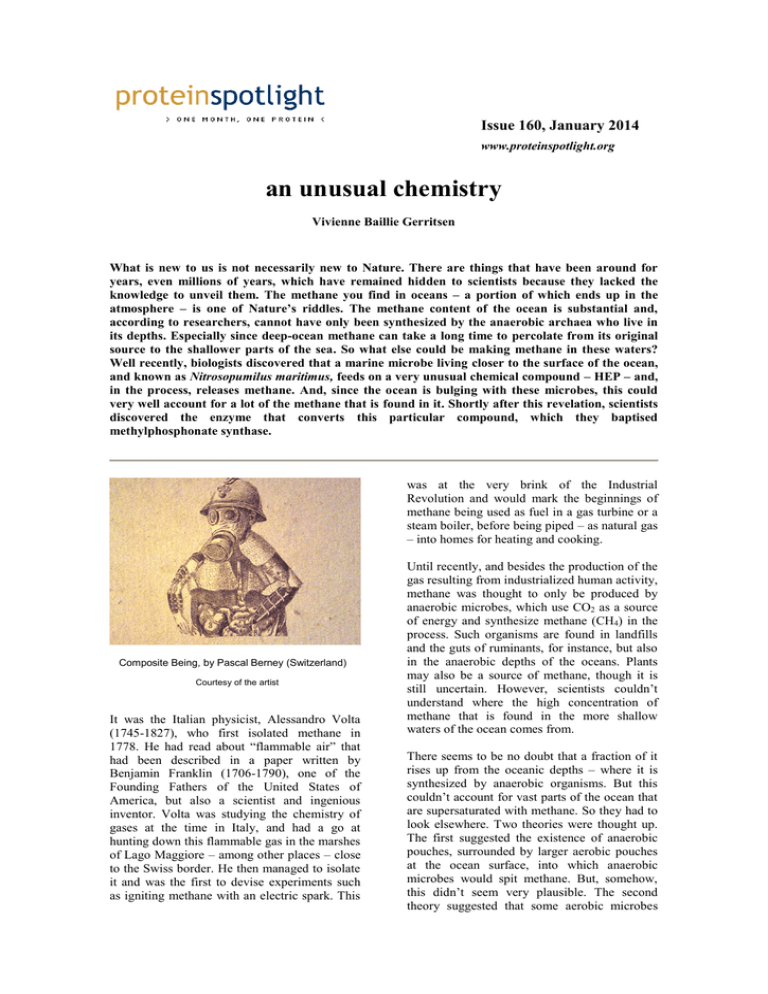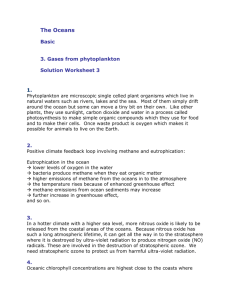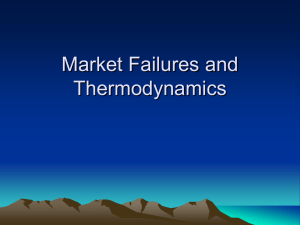an unusual chemistry
advertisement

Issue 160, January 2014 www.proteinspotlight.org an unusual chemistry Vivienne Baillie Gerritsen What is new to us is not necessarily new to Nature. There are things that have been around for years, even millions of years, which have remained hidden to scientists because they lacked the knowledge to unveil them. The methane you find in oceans – a portion of which ends up in the atmosphere – is one of Nature’s riddles. The methane content of the ocean is substantial and, according to researchers, cannot have only been synthesized by the anaerobic archaea who live in its depths. Especially since deep-ocean methane can take a long time to percolate from its original source to the shallower parts of the sea. So what else could be making methane in these waters? Well recently, biologists discovered that a marine microbe living closer to the surface of the ocean, and known as Nitrosopumilus maritimus, feeds on a very unusual chemical compound – HEP – and, in the process, releases methane. And, since the ocean is bulging with these microbes, this could very well account for a lot of the methane that is found in it. Shortly after this revelation, scientists discovered the enzyme that converts this particular compound, which they baptised methylphosphonate synthase. was at the very brink of the Industrial Revolution and would mark the beginnings of methane being used as fuel in a gas turbine or a steam boiler, before being piped – as natural gas – into homes for heating and cooking. Composite Being, by Pascal Berney (Switzerland) Courtesy of the artist It was the Italian physicist, Alessandro Volta (1745-1827), who first isolated methane in 1778. He had read about “flammable air” that had been described in a paper written by Benjamin Franklin (1706-1790), one of the Founding Fathers of the United States of America, but also a scientist and ingenious inventor. Volta was studying the chemistry of gases at the time in Italy, and had a go at hunting down this flammable gas in the marshes of Lago Maggiore – among other places – close to the Swiss border. He then managed to isolate it and was the first to devise experiments such as igniting methane with an electric spark. This Until recently, and besides the production of the gas resulting from industrialized human activity, methane was thought to only be produced by anaerobic microbes, which use CO2 as a source of energy and synthesize methane (CH4) in the process. Such organisms are found in landfills and the guts of ruminants, for instance, but also in the anaerobic depths of the oceans. Plants may also be a source of methane, though it is still uncertain. However, scientists couldn’t understand where the high concentration of methane that is found in the more shallow waters of the ocean comes from. There seems to be no doubt that a fraction of it rises up from the oceanic depths – where it is synthesized by anaerobic organisms. But this couldn’t account for vast parts of the ocean that are supersaturated with methane. So they had to look elsewhere. Two theories were thought up. The first suggested the existence of anaerobic pouches, surrounded by larger aerobic pouches at the ocean surface, into which anaerobic microbes would spit methane. But, somehow, this didn’t seem very plausible. The second theory suggested that some aerobic microbes might be able to synthesize methane. But which ones? And how do they do it? One solution – to what had been coined “the methane paradox” – was the capacity of aerobic microbes to use 2-hydroxethylphosphonate – or HEP – as an energy source. In doing so, they would release methane. The only problem was that, until recently, HEP had not only never been found in marine ecosystems but was not believed to be a natural compound. What is more, anything entailing phosphonate biosynthesis seems to involve unusual biochemistry. Despite these drawbacks, it turned out that HEP is indeed a natural compound. It’s just that it is not released into the ocean waters but remains on the surface of other microbial cells that produce it. Then,microbes hungry for phosphorus, such as Nitrosopumilus maritimus, gather HEP off the microbial cells’ membranes, use the phosphorus for energy and release methane into the ocean as a side thought. The enzyme responsible for plucking the phosphorus off HEP has been called methylphosphonate synthase (MpnS). MpnS is a non-heme iron-dependent oxygenase able to convert 2-hydroxyetylphosphonate (2HEP, C2H7O4P) to methylphosphonate by cleaving the unactivated C-C bond. Subsequent steps in phosphonate biosynthesis, performed by other enzymes, result in the synthesis of methane, which is finally released into the ocean in the form of gas. The same gas which rises out of the ocean and ends up in the earth’s atmosphere to become part of the now infamous greenhouse gas. Naturally, Nitrosopumilus maritimus is not the only microbial organism able to synthesize methane, many of its relatives – for example Pelagibacter – are no doubt able too as well. And, as it is estimated that their global population in the upper 200 metres of the world’s oceans is something around 3.6 x 1028, it could very easily account for the ocean’s supersaturation of methane. As scientists have put it, this theory is a plausible explanation for the methane paradox, despite the unusual biochemistry involved... So it all remains very hypothetical, to say the least. Yet studies like these are important for understanding the role of methane in the biosphere’s carbon cycle, and for establishing climate change models. And, is it not still comforting to realise that, despite an industrial revolution and over 200 years of scientific research, Nature still manages to keep some of her secrets to herself. Cross-references to UniProt Methylphosphonate synthase, Nitrosopumilus maritimus: A9A1T2 References 1. Metcalf W.W., Griffin B.M., Cicchillo R.M., Gao J., Janga S.C., Cooke H.A., Circello B.T., Evans B.S., Martens-Habbena W., Stahl D.A., van der Donk W. Synthesis of methylphosphonic acid by marine microbes: A source for methane in the aerobic ocean Science 337:1104-1107(2012) PMID: 22936780 2. Cooke H.A., Peck S.C., Evans B.S., van der Donk W.A. Mechanistic investigation of methylphosphonate synthase, a non-heme iron-dependent oxygenase Journal of American Chemical Society 134:15660-15663(2012) PMID: 22957470 Protein Spotlight (ISSN 1424-4721), http://www.proteinspotlight.org, is published by the Swiss-Prot group at the SIB Swiss Institute of Bioinformatics. Authorization to photocopy or reproduce this article for internal or personal use is granted by SIB provided its content is not modified. Please enquire at spotlight@isb-sib.ch for redistribution or commercial usage.






